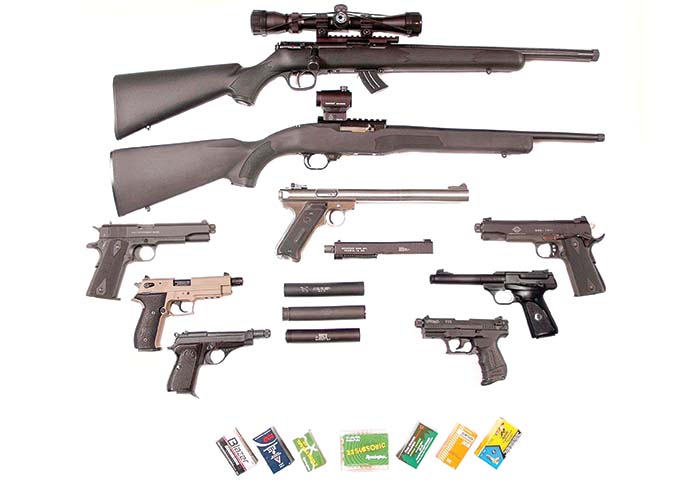Just a few examples of the .22 caliber firearms available for suppressor use.
By Frank Iannamico
Sound suppressors, also known as “silencers” by ATF and Hollywood or “cans” by enthusiasts, have become extremely popular in recent years. Many manufacturers of rifles and pistols now offer models with factory threaded barrels. There have also been a growing number of companies entering into the suppressor business. The suppressor competition is good news for the end user as the technology will continue to improve.
Modern suppressors are now smaller, lighter and quieter than those produced just a few years ago. The most innovative step forward was the introduction of the wipeless suppressor. During the 1960s there were very few U.S. companies making sound suppressors; one of the best known was Sionics (acronym for Studies In the Operational Negation of Insurgents and Counter-Subversion) operating out of Atlanta, Georgia. The Sionics Company, run by Mitch WerBell, specialized in the manufacture of covert products and their primary product was sound suppressors. Sionics’ customers were the military and governments, both foreign and domestic and offered sound suppressors for a number of military rifles and pistols.
In the late 1960s, Sionics began the manufacture of Gordon Ingram’s Model 10 submachine gun, and the company name was changed to the Military Armament Corporation. The sound suppressors designed and produced for the Model 10 was a two-stage design using metal eyelets in the first stage, right and left spirals and wipes in the second stage. The suppressors were made in .380 caliber, 9mm, and .45 ACP. The MAC suppressors were large and heavy. As the suppressors were used they became progressively louder as the rubber wipes deteriorated and become less efficient. After approximately 200 rounds the wipes had to be replaced.
After The Military Armament Corporation went out of business, the Sionics/MAC suppressor designs continued to be manufactured by RPB and a few years later by SWD. It was at this point in time the suppressors became much more available to the general public, where permitted by law. A number were sold, but they were not especially popular, primarily because of the registration process, and the transfer tax that was usually more than twice the cost of the suppressor.
During the 1980s unregistered suppressor tubes and baffles were offered for sale, but advertised separately. Tubes were available from one company and the internal components from another, often the same company operating under different names. Similar sales were being made at gun shows from separate tables, all perfectly legal at the time. Before long, law enforcement officials were reporting a large number of illegal suppressors being seized. These types of sales strategies are what led to current laws banning the possession of spare suppressor parts.
Today, those in the market for a sound suppressor have a lot of options and many models available for them to consider. The most popular are those designed for .22 caliber rimfire rifles and pistols. This article is to introduce the reader to some of the more popular host firearms for mounting a .22 caliber suppressor.
Ruger 10/22 Rifle

The Ruger semiautomatic .22 caliber rifle introduced in 1964, celebrated its 50th year of production in 2014. The Ruger 10/22 rifle is one of the most popular .22 caliber firearms ever made with more than 6 million sold since its introduction.
The Ruger 10/22 rifle has proven to be a very reliable semiautomatic rifle. Since its introduction there have been several minor changes in its design and construction materials. As delivered from the factory the 10/22 rifle is fed from a 10-round rotary magazine.
The Ruger 10/22 rifle is currently available in seven different models. For those interested in mounting a suppressor, the obvious choice would be the 10/22 Tactical Model 1261 that comes from the factory with a 1/2-28 threaded 16.12-inch long barrel, synthetic stock, extended magazine release, and accessory rail for mounting optical devices. The rifle does not have conventional sights.
If you have an older model of the Ruger 10/22 there is a very large accessory aftermarket for upgrading the rifle. Available accessories include large capacity magazines, target and tactical stocks, threaded barrels and much more. The barrel of the 10/22 can be easily removed to be threaded for a suppressor or replaced with a new threaded one.
Savage Mark II FV-SR Rifle

When firing a suppressed semiautomatic rifle or pistol, sound is generated from several sources: the muzzle of the weapon, the ejection port, the action cycling and the bullet impacting the target. Other than the muzzle report, many of these sounds are not normally heard when firing unsuppressed firearms.
Firing a suppressed bolt-action rifle eliminates the sound generated from the ejection port and the semiautomatic action cycling, until of course the rifle’s bolt-action is cycled by hand after the shot, making a bolt-action rifle the best choice for the ultimate in quiet. A suppressed .22 rimfire caliber bolt-action rifle can be phenomenally stealthy.
The bolt-action Savage Mark II FV-SR has been a very popular choice for mounting a suppressor. The rifle comes from the factory fitted with a 16.5-inch 1/2-28 threaded heavy-profile, free-floating, fluted barrel, oversize bolt handle, Picatinny style optics rail, the adjustable Savage factory AccuTrigger, black synthetic stock and 5 or 10-round detachable magazine. The barrel comes with a knurled thread protector the same diameter as the heavy barrel.
When fitted with a red dot or telescopic sight the Savage Mark II FV-SR can be an accurate rifle.
One problem encountered was with the magazine. The metal body is pressed together and after reloading the magazine a few times the sides spread apart and the cartridges would not stay in the magazine. An internet inquiry revealed this to be a common problem.

Walther P22
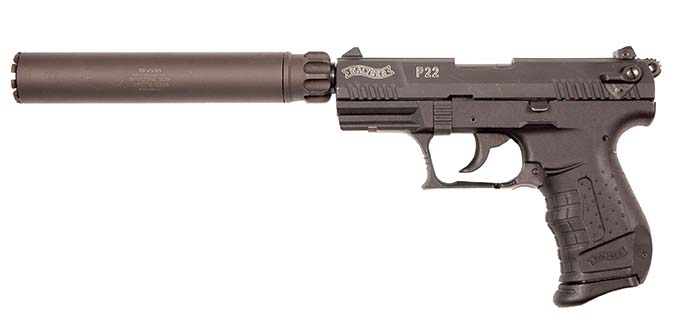
The Walther P22 has been an inexpensive and popular .22 caliber pistol for mounting a suppressor. The pistol features a double-action first shot, and single action for subsequent shots. The pistol’s frame is made of polymer with stamped steel internal components; the slide is made from a zinc alloy. The barrel, recoil spring guide, extractor and ejector are made of steel. The magazine is constructed of stainless steel with a polymer follower and bump pad. An interchangeable backstrap allows the grip to be customized to the shooter’s hand. Sights consist of a polymer ramp front sight with a white dot pressed into the slide and a polymer rear sight adjustable for windage with two white dots. Two additional front sights come with the pistol to adjust elevation. The P22 features an ambidextrous magazine release located at the back of the trigger guard. Under the frame is a rail for the mounting accessories, including a factory laser designed specifically for the P22. The P22 is available in several variations as well as quite a few color options.
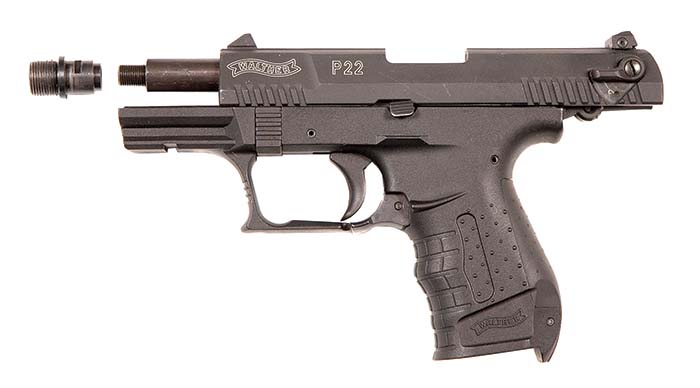
SIG Mosquito
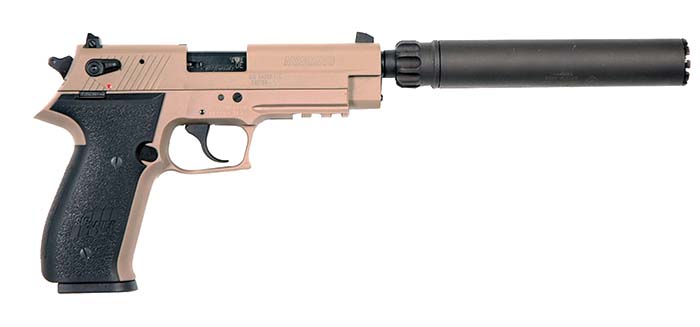
The .22 caliber SIG Sauer Mosquito is a medium-size, double-action; semiautomatic pistol with an appearance, with the exception of its slide-mounted safety, and operation similar to that of the SIG Sauer P226 model. For the SAR evaluation the Mosquito “Silencer” TB model was tested. The silencer model is a bit of a misleading name. While the pistol does have an extended, threaded barrel, an aftermarket adapter is still required for attaching a suppressor with standard 1/2-28 threads.
The Mosquito’s slide is made of an aluminum-zinc alloy. Mounted on the slide are a blade front sight and adjustable rear, both with yellow-green inserts. The sights are tall enough to be visible with most brands of .22 suppressors on the barrel. The Mosquito has a polymer frame and has an integrated Picatinny rail for a light or accessory. The pistol has a slide-mounted, ambidextrous, manual safety switch located below the rear sight. A second safety feature requires the magazine to be in place before the pistol will fire. For storage or security purposes there an integral, key-operated safety lock located at the base of the grip. Located just forward of the slide catch lever is a decocking lever. Magazine capacity is 10 rounds. The fixed steel barrel is blued with a length of 4.9-inches. The Mosquito is available in several color combinations.
There have been a few reliability problems reported in early manufacture Mosquito pistols, but the problem seems to have been addressed. Three different pistols were tested with only one or two failures to feed using a variety of .22 ammunition brands. There was an ongoing reliability problem with Aguila Subsonic ammunition, but there was flawless reliability with CCI Standard Velocity, which has traditionally been the most popular .22 ammo for suppressor use. The Mosquito comes with two recoil springs, one for high-speed loads and another for standard ammunition. The pistol comes from the factory fitted with the high-speed spring. Also included is a wrench designed to remove the factory thread protector, a set of shorter sights and a safety locking key.
The SIG Mosquito has the look and feel of a center fire pistol. Like some other .22 caliber firearms it can be ammunition sensitive; some trial and error may be required to find ammunition that is compatible with any particular pistol.
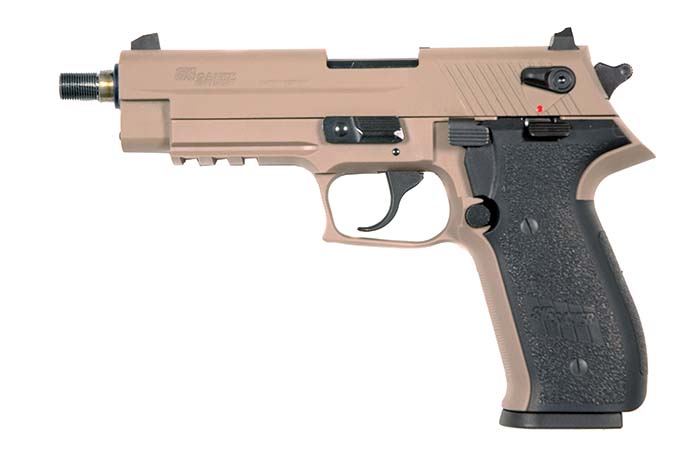
Ruger Mark II
The Ruger series of single-action, semiautomatic .22 caliber pistols are very popular and have been in continuous production for over 65 years. Ruger’s first semiautomatic pistol was the Standard, made from 1949 to 1982. The original design was replaced by the new Mark II model in 1982. The MK II featured a slide stop that held the slide open on the last round, and was available in stainless steel. Other MK II variations include the Target models with heavier barrels and adjustable sights, and the 22/45 models, with a polymer frame having the same grip-angle as a 1911 pistol. The MK II was replaced by the Mark III in 2004. The Mark III introduced a number of new safety features: a visible loaded chamber indicator, a magazine disconnect that prevents the pistol from being fired with the magazine removed and an internal safety lock that locks the pistol in the “safe” position with a key. Other non-liability features include tapered bolt ears, contoured ejection port, and relocated magazine release.
Unlike many of the newer .22 caliber pistols, the Ruger Mark pistols (except for the polymer frame 22/45 Model) have a steel frame and slide. The magazines also are made of steel have a 10-round capacity.
Due in part to its popularity and many years in production there is a large choice of aftermarket parts and accessories for the Ruger line.
Ruger .22 pistols are available in a large number of configurations and barrel options to include the Standard, Target, Hunter and Competition models. Ruger currently offers their SR-22 and the 22/45 .22 caliber pistols with factory threaded 1/2-28 barrels.
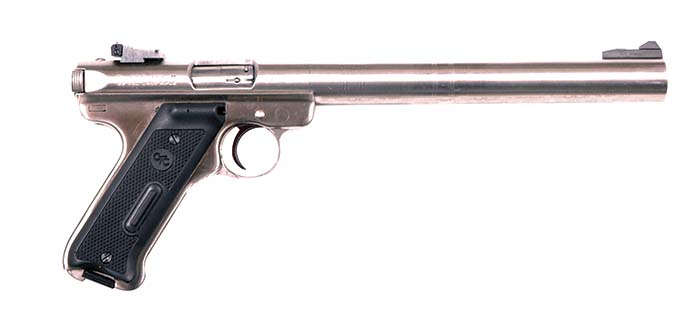
Colt/Walther 1911A1
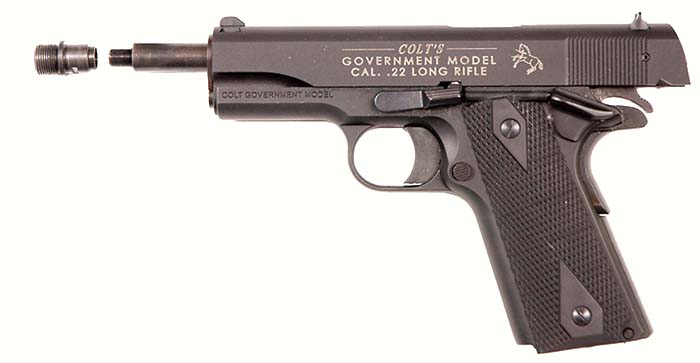
John Browning’s original 1911 pistol design has been one of the most popular handguns in the U.S. for a long time. Since its introduction, it has become available in many configurations and manufactured by an ever-growing number of companies. The basic 1911 has been offered in a number of popular calibers including the original .45 ACP, .38 Super, 9mm and .22 rimfire. Recently there have been a rather large number of dedicated .22 caliber variants introduced to the market.
Walther/Umarex manufactures a full-size .22 caliber 1911 single-action pistol under license from Colt in Germany. The pistol was designed and manufactured according to the original Colt plans and at a 1:1 scale and accepts many regular 1911 accessories, this alone makes this gun appealing to many.
The Colt/Walther Government 1911A1 is chambered in .22LR with a magazine capacity of 12 rounds. It weighs 2.25 pounds empty, and it has an aluminum slide and a zinc alloy frame. Like the standard 1911, the .22 variant has both manual thumb and grip safeties. The standard 1911 style sights this comes equipped with should be tall enough to be usable with most modern .22 suppressors on the market. Disassembly is similar to a standard 1911. The .22 replica has a M8x.75mm 5.5 inch threaded barrel. While this barrel does not extend past the slide, it has a thread protector that can be removed to expose the metric muzzle threads. This allows the user to attach a readily available 1/2-28 thread adapter for attaching a suppressor.
Many enthusiasts have voiced concern about the use of the zinc alloy used in many of the .22 pistols available today, with visions of the old fragile “pot metal” of old. Unlike .22 caliber pistols designed exclusively for that caliber, when designing a replica of a modern center-fire pistol gun in .22 caliber, the slide must be made from a light-weight alloy material in order for the pistol to function with the low power round. Walther has stated that the material they use is a sophisticated zinc alloy that they selected for its durability, and the company has stated that they do not anticipate any issues with the material.

GSG 1911

The German Sports Guns (GSG) 1911 designed .22 caliber single-action pistol is another copy of the famous 1911A1 pistol. All the controls are pretty much the same as any government issue. The gun weighs 34 ounces, which is just a few ounces lighter than a typical .45 1911, thus it feels like a “real” 1911, except for the stiff grip safety that you must consciously depress. Some of the early production of the GSG 1911 had some reliability issues. However this has been acknowledged by the manufacturer who offers an upgrade package that consists of a new recoil spring and guide rod assembly. The pistol tested had a very sluggish slide that often did not have enough forward velocity to strip a round from the magazine. The problem was easily fixed with the new spring and guide rod factory upgrade.
The GSG 1911 comes with a number of so-called “enhanced” features that used to be only found on custom 1911s including ambidextrous safety, beavertail grip safety, extended trigger with adjustable “commander” style hammer, and extended magazine catch. The pistol slide remains open on an empty magazine, and the magazine release and slide stop function are the same as a 1911. The slide of the GSG-1911 is aluminum and the frame/receiver body of the pistol is a Zinc alloy. The barrel is fixed in position. A fair amount of parts of the GSG 1911 are interchangeable with a standard 1911 pistol.
Takedown for cleaning the GSG 1911 was a little more complicated than a .45 caliber model with an extra screw that has to be removed to disassemble the pistol.
Browning Buck Mark
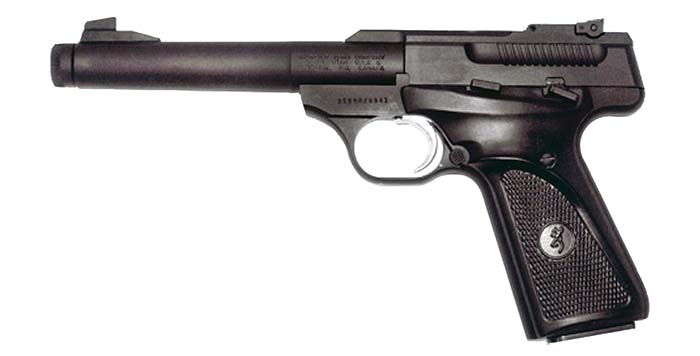
The Buck Mark pistol is one of the most proven 22 rimfire designs available today. The Buck Mark has been in continuous production since 1985. The Buck Mark replaced both the Browning Challenger and International pistol models.
Over the years the design of the Buck Mark has remained very similar with refinements primarily in aesthetics, grips and available finishes. The Buck Mark pistol is designed with a straight blowback action, the frame is CNC machined from 7075-T6 aluminum. The gun comes equipped with a thumb safety as well as front and rear iron sights. Features for some models include a bull barrel, full length scope rail, wooden comfort grips, and Pachmayr grips. The magazine has a 10-round capacity. There are currently 15 models offered of the Browning Buck Mark pistol. The Browning pistol features a very smooth trigger action, not very common in many .22 caliber pistols today. The Buck Mark is reliable with just about any brand of .22 caliber ammunition currently available.
While a very popular and well regarded design, the Buck Mark pistol performs best when kept clean. Most .22 caliber ammunition is inherently dirty, and firing a pistol with a suppressor expedites the buildup of powder residue and grime. The disassembly and cleaning process is a bit more complicated and involved than most other .22 pistols.
One disadvantage to the currently available Buck Mark pistols is the lack of a factory-threaded barrel option. While threaded replacement barrels are available, it adds additional expense to the basic cost of the pistol.
Beretta Model 71
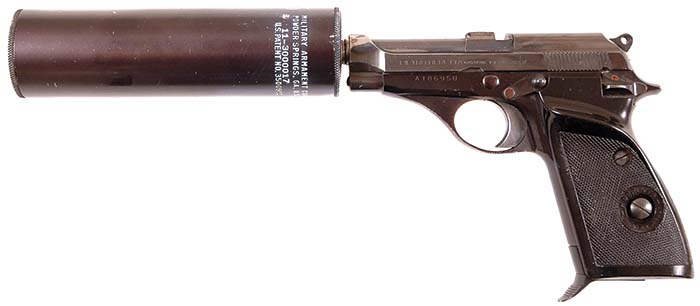
The Beretta Model 71 is a well built and finished single-action handgun that was produced from 1958 through 1985, with fine workmanship and quality control common on Beretta made firearms. The commercial Model 71 was once imported as the Jaguar. What makes the Beretta Model 71 particularly interesting is that they have served as the “special purpose” weapon of choice for the Israeli Mossad intelligence agency.
The Model 71 is a single-action semiautomatic with an 8-round magazine and fixed sights. The frame is aluminum and the slide is steel. On the left-hand side of the frame, there’s a slide-stop lever and a thumb-operated safety blocks the sear and hammer. On the right-hand side, there is a lever marked “disassembly” which, when moved forward, allows the removal of the slide and barrel assembly from the frame. The magazine release is a large, recessed push button on the lower left side of the grip. The left side of the slide reads: “PIETRO BERETTA, Gardone V.T. Cal. 22 L.R.” The right side: “P B–Made in Italy.” The importer isn’t saying what country the pistols came from, but an instruction manual written in Turkish has been found accompanying one pistol. The left side of the frame carries the original serial number and Italian proof marks which include an Italian production code for the year of manufacture. The production code on the test pistol consists of the letters “AH” inside a square box, indicating that it was produced in 1981.
The Model 71 uses Beretta’s characteristic open frame design with the exposed barrel. There are no plastic or zinc-alloy parts in the Beretta; the only parts not made of steel are the plastic grips, magazine follower and aluminum alloy frame. The Model 71 was the only pistol tested that worked flawlessly with every type of ammo tried, including the seemingly low-powered Aguila brand Super Extra Subsonic. Although the Model 71 tested had a factory threaded barrel, the 1/2-20 threads required an adapter to fit a 1/2-28 thread suppressor. The only problem in shooting the Model 71 is the sights are totally obscured by a suppressor. When a suppressor is on the barrel the pistol becomes a point-and-shoot weapon.
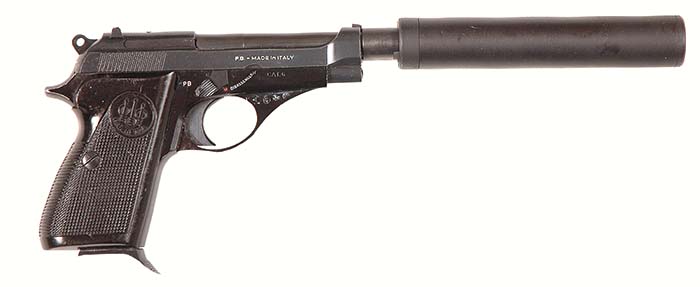
Advantage Arms
Advantage Arms makes .22 caliber conversion kits for Glocks, 1911 pistols, and Springfield Armory XD models. The company also offers threaded barrels for their kits.
Of course there are many more suitable host firearms for mounting a .22 caliber suppressor than those addressed here, however covering all of them is beyond the scope of this article. Nevertheless, having such a wide ranging choice of host weapons and suppressors is good for the shooting community.
| This article first appeared in Small Arms Review V19N3 (April 2015) |



